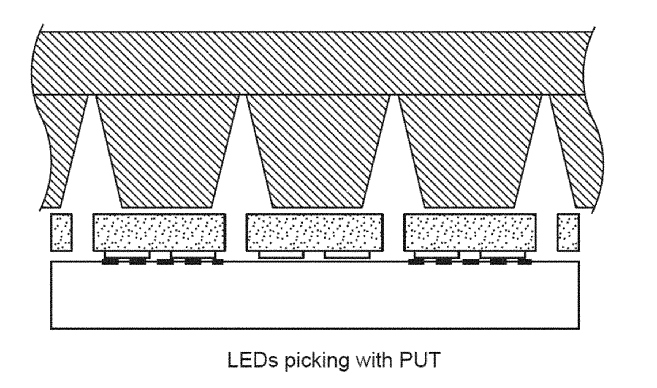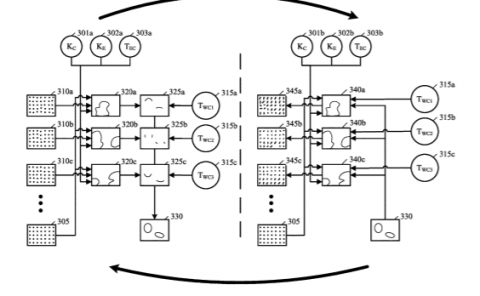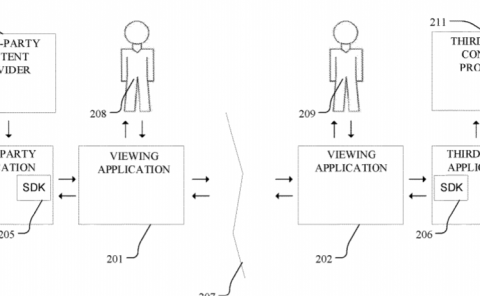Oculus | Method And Apparatus For Use In The Manufacture Of A Display Element
Patent: Method And Apparatus For Use In The Manufacture Of A Display Element
Publication Number: 20180332744
Publication Date: 2018-11-15
Applicants: Oculus VR, LLC

Abstract
Methods and apparatus for use in the manufacture of a display element. Some embodiments include a method for selective pick up of a subset of a plurality of electronic devices adhered to a handle layer. The method comprises modifying a level of adhesion between one or more electronic devices of the plurality of electronic devices adhered to the handle layer, such that the subset of the plurality of electronic devices has a level of adhesion to the handle layer that is less than a force applied by a pick up tool, PUT. This enables selective pick up of the subset of the plurality of electronic devices from the handle layer by the PUT.
BACKGROUND
Displays are ubiquitous and are a core component of many wearable electronic devices, smart phones, tablets, laptops, desktops, TVs and display systems. Common display technologies today range from Liquid Crystal Displays (LCD's) to more recent Organic Light Emitting Diode Displays (OLEDs).
Display architectures include passive and active matrix displays depending on whether each pixel is driven separately or not. Active drive circuitry uses thin film transistor (TFT) technology where transistors based on amphorous, oxide or polysilicon technology are manufactured on glass panels which may have glass substrate sizes from the 1st generation of 30 cm.times.40 cm to the 10th generation (known as GEN10) of 2.88 m.times.3.15 m.
However, in most portable devices (i.e. battery powered devices) the display uses the majority of the available battery power. Additionally, the most common user issue for portable devices is insufficient display brightness. To extend battery life and improve brightness levels, it is may be desirable to reduce power consumption and produce higher luminance emission from the light source.
Inorganic light-emitting diode (ILED) displays are emerging as the next generation of flat display image generators providing superior battery performance and enhanced brightness. The ILED display is, at a basic level, a variation of the organic light-emitting diode (OLED) display. OLEDs pass current through organic or polymer materials that are sandwiched between two glass planes to produce light. ILEDs replace the organic LED material with a discrete standard LED (which is made of inorganic materials) at each pixel of the display (each pixel consists of three individual Red, Green and Blue LEDs for color displays).
Standard (i.e. inorganic) LED devices have been around for many years and their performance (efficiency, brightness, reliability and lifetime) has been optimized over many years as the LED industry has pursued many commercial opportunities--especially the challenge of developing LED technology to enable it to replace the standard incandescent bulbs for general light applications, i.e. inorganic LEDs are significantly more efficient, bright and reliable than the new and less developed OLED materials.
The concept of individually switchable standard LEDs (R, G & B) at each pixel in a display is well known. This approach is in widespread use for large information displays. However, to-date it has not been possible to scale this approach down to smaller displays as standard LEDs are typically planar chips which are inefficient for light direction control. Additionally, the assembly of the many millions of pixels needed for a laptop or smart phone display is not feasible using standard assembly manufacturing techniques.
SUMMARY
Disclosed herein is a manufacturing assembly method for ILED displays, i.e. assembling millions of inorganic LED dies in a matrix array to produce an LED display.
Exemplary embodiments relate to a method of patterning a handle layer in order to selectively release dies for picking, and to enable a selectable pick up tool (PUT) to be used in a micro-assembly.
The handle layer may be UV tape. The UV tape is selectively irradiated (patterned) with a UV light only below the LEDs (this is termed a corresponding section of the handle layer, in that it corresponds to the location of an LED device) which need to be picked. The adhesion between these LEDs and the tape is decreased, which allows a picking of the selected chips by a PUT during the pick action of a micro-assembly pick and place cycle.
The UV light can be from any UV source that can be used for patterning, such as UV laser, UV LED Array or UV light and mask.
Other handle layers such as thermal release tape, multiple layer tape or any adhesion switchable layer can be alternatively used.
This method enables the selective: removal of known bad dies from a wafer/handle layer or substrate, picking of dies for the placement of only known good die during the transfer print operation, or picking of a reduced subset of the full LED array on a PUT during a transfer print cycle.
Alternatively, the irradiated patterned treatment of the handle layer can enhance rather than reduce the adhesion of specific die to the handle layer in order to manage and control the picking of die.
Some embodiments include a method for selective pick up of a subset of a plurality of electronic devices adhered to a handle layer. The method comprises modifying a level of adhesion between a subset of electronic devices of the plurality of electronic devices adhered to the handle layer such that the subset of electronic devices has a modified level of adhesion to the handle layer; and separating, by a pick up tool (PUT), the subset of electronic devices from the handle layer by applying a force to the subset of electronic devices that is greater than the modified level of adhesion of the subset of electronic devices to the handle layer.
A second subset of electronic devices is adhered to the handle layer with the level of adhesion that is greater than the force applied by the PUT. The force does not separate the second set subset of electronic devices from the handle layer when the subset of electronic devices is separated from the handle layer. As such, the subset of electronic devices is selectively separated from the handle layer while the second subsequent of electronic devices remain adhered to the handle layer.
Modifying the level of adhesion may include reducing the level of adhesion of the subset of electronic devices with the handle layer.
The PUT may apply the force to the subset of electronic devices by adhesion. The method may further comprise contacting the PUT with the subset of electronic devices.
The PUT may be a non-selective PUT.
Modifying the level of adhesion between the subset of electronic devices and the handle layer may comprise heating the subset of electronic devices and/or corresponding portions of the handle layer where the subset of electronic devices are adhered.
Modifying the level of adhesion between the subset of electronic devices and the handle layer may comprise applying a liquid stimulus to the subset of electronic devices and/or the corresponding portions of the handle layer where the subset of electronic devices are adhered.
Modifying the level of adhesion between the subset of electronic devices and the handle layer may include controlling adhesion of microstructures of the handle layer.
Modifying the level of adhesion between the subset of electronic devices and the handle layer may comprise irradiating with light corresponding portions of the handle layer where the subset of electronic devices are adhered.
The light may comprise ultraviolet (UV) light.
The UV light may originate from one or more of: a UV laser; a UV LED array; or a UV light source passed through a photolithography mask.
The method may further include, subsequent to separating the subset of electronic devices from the handle layer: modifying the level of adhesion between the second subset of electronic devices adhered to the handle layer such that the second subset electronic devices has the modified level of adhesion to the handle layer; and separating, by the PUT, second the subset of electronic devices from the handle layer by applying the force to the second subset of electronic devices that is greater than the modified level of adhesion of the second subset of electronic devices to the handle layer.
The method may further include transferring, by the PUT, the subset of electronic devices to a substrate at locations where defective electronic devices were removed from the substrate.
The method may further include manufacturing the electronic devices on a wafer; singulating the electronic devices on the wafer; and adhering the singulated electronic devices to the handle layer.
The electronic devices adhered to the handle layer may comprise light emitting diode (LED) devices.
The electronic devices adhered to the handle layer may comprise inorganic LED devices.
The electronic devices adhered to the handle layer may comprise micro-LED (.mu.LED) devices, each .mu.LED device comprising a .mu.LED emitter including: a substantially parabolic mesa structure; a light emitting source within the mesa structure; and a primary emission surface on a side of the .mu.LED device opposed to a top of the mesa structure.
The handle layer may comprise any one of: a semiconductor wafer; a UV tape; a thermal release tape; a multiple layer tape; or an adhesion adjustable layer.
The method may further comprise transferring, using the PUT, the subset of electronic devices to a substrate of a display element.
Some embodiments may include a non-transitory computer readable storage media including a computer program comprising instructions which, when executed by at least one processor, configures the at least one processor to perform the methods discussed herein.



